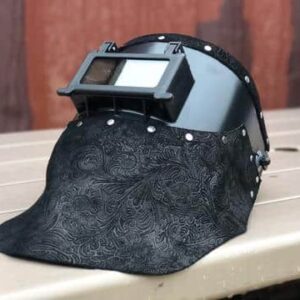Table of Contents
How to Customize Your Leather Welding Hood for Perfect Fit & Comfort
When it comes to welding, comfort and safety go hand-in-hand. A well-fitting welding hood can make a world of difference, ensuring your face and head are fully protected without compromising mobility or comfort. If your leather welding hood feels bulky, too tight, or just doesn’t sit right, customizing it for a better fit can be a game-changer. Here’s a practical guide on adjusting and personalizing your leather welding hood to suit your needs.
1. Start with the Right Leather
Not all leather is created equal, especially when it comes to welding hoods. Since welding can expose you to intense heat and sparks, look for high-quality, durable leather that can withstand these conditions. Thicker leather not only offers better protection but also adds a sturdier structure to the hood, making it more resilient.
Some welders prefer softer, more flexible leather as it allows the hood to move with them, reducing strain. Others opt for rigid leather that holds its shape better and offers a snug, protective fit. Selecting the right type of leather based on your comfort and work environment is the first step in achieving a hood that fits and protects effectively.
2. Adjust the Straps for a Comfortable Fit
Leather welding hoods often come with adjustable straps, but they might need tweaking for a secure, comfortable fit. Here’s how to make those adjustments work for you:
- Forehead and Back Straps: Adjust the forehead and back straps so that the hood sits securely on your head without slipping. If the leather straps feel too stiff, conditioning them with leather oil can make them more flexible and comfortable.
- Chin Strap: Some leather welding hoods include a chin strap to keep the hood steady. Adjust the chin strap so it’s snug but not tight, allowing you to speak or move your jaw comfortably while working.
- Side Straps or Buckles: These can help with side-to-side adjustments. Properly secured side straps keep the hood from shifting as you move, especially when working in awkward positions.
These small adjustments can significantly improve how the hood feels on your head, reducing the need to constantly readjust while you’re on the job.
3. Modify the Fit with Padding
Adding padding to your leather welding hood can make it more comfortable, especially for long hours of wear. Padding can be strategically placed around the forehead, back of the head, or even the sides to achieve a custom fit.
Consider using materials like foam inserts, felt, or padded liners. They can be easily attached to the inside of the hood with Velcro or leather-safe adhesive. With a bit of trial and error, you can find the right amount and placement of padding to make your hood fit comfortably without pressing or slipping.
4. Use Leather Conditioners for Flexibility
Leather can sometimes feel rigid, especially when new. Conditioning your leather welding hood can make it softer and more pliable, allowing it to mold better to your head shape. Here’s how to do it effectively:
- Leather Oil or Conditioner: Apply a small amount of leather oil or conditioner to a soft cloth and gently rub it into the leather. This will make it more flexible and comfortable over time.
- Let It Dry Properly: After conditioning, let the hood dry thoroughly to ensure it doesn’t feel greasy. This also prevents dust and debris from sticking to the leather.
- Repeat As Needed: Conditioning leather is not a one-time fix. Regular conditioning helps maintain the hood’s flexibility and durability, so incorporate this step periodically to keep your hood in optimal shape. you may like
5. Add Personal Touches for Practicality
A customized leather welding hood is not just about the fit; it’s also about making it work for you. Adding functional customizations can make your hood more practical, especially for specific tasks:
- Magnification Lenses: If you often need close-up visibility, consider adding a magnifying lens to the hood. Some hoods have slots for lenses, or you can make small modifications to install one.
- Ventilation Holes: Leather can get hot, especially during long jobs. If ventilation is a concern, carefully punch small holes in non-essential areas to improve airflow. Ensure these holes are placed strategically so they don’t compromise safety.
- Personalized Stitching or Embossing: To make your hood uniquely yours, you can add stitching in contrasting colors or embossing with initials or a logo. These aesthetic touches can make your hood stand out without affecting its functionality.
6. Test for Comfort and Safety
Once you’ve made adjustments, it’s essential to test your customized hood. Wear it in a safe, controlled environment to ensure it fits well and doesn’t hinder your vision or movement. Take note of any discomfort or issues that arise and make additional tweaks as necessary. A hood that’s custom-fitted should allow you to move freely without sacrificing protection.
Consider running a quick checklist:
- Fit Check: Ensure it doesn’t shift when you turn your head or bend.
- Comfort Test: The hood should not press uncomfortably on any part of your head.
- Vision and Safety: Verify that the hood sits properly over your eyes and provides the necessary protection without blocking your view.
7. Maintain Your Hood for Long-Term Comfort
Your leather welding hood is an investment, and maintaining it well can extend its life and keep it comfortable over time. Clean it regularly with a soft cloth to remove dirt and grime, and reapply leather conditioner every few months to keep it soft and flexible. Regularly inspect the straps, buckles, and any added padding to make sure everything is secure and in good shape.
Conclusion
Customizing your leather welding hood can make a significant difference in your welding experience, enhancing both comfort and protection. By investing time in adjustments and small personal touches, you’ll have a hood that not only fits well but also feels like an extension of yourself on the job. So, take these steps, put your unique spin on your hood, and see how a better fit can improve your performance and safety at work.
Ready to start your customizations?
With these tips, you can get the perfect fit that lets you focus on the job, not on adjusting your gear.




